First Drive: BMW’s All-Electric 7 Series Is a Tech Spectacular That Might Just Make You Forget Its Stately Ride

- Oops!Something went wrong.Please try again later.
Saving the best for last on a driving tour of architectural masterpieces in Palm Springs, Calif., we finally arrived at to the House of Tomorrow. Built in 1960, the residence is also known as the Elvis and Priscilla Honeymoon Hideaway and looks like a spaceship jutting out above the cul-de-sac location. It’s an ideal destination for the 2023 BMW i7 xDrive60 during the global launch based down the road in Rancho Mirage.
The first all-electric 7 Series shares the sober aesthetic of its gasoline-powered, 48-volt mild-hybrid siblings, the 740i and 760i xDrive. The formal profile is only relieved by a crease here and a bit of chiseling there. The car is like a five-foot-tall Homburg hat with a massive panoramic roof instead of the chapeau’s creased “gutter crown.” Yet the interior lights up like a raving party with umpteen tones of ambient LEDs in dazzling patterns while the Sky Lounge feature’s multicolor beams that strafe through the glass overhead.
More from Robb Report
'The Game's Changing': New EV Buyers Are Throwing Brand Loyalty to the Wind
The McMurtry Spéirling Just Became the World's Fastest Production Car
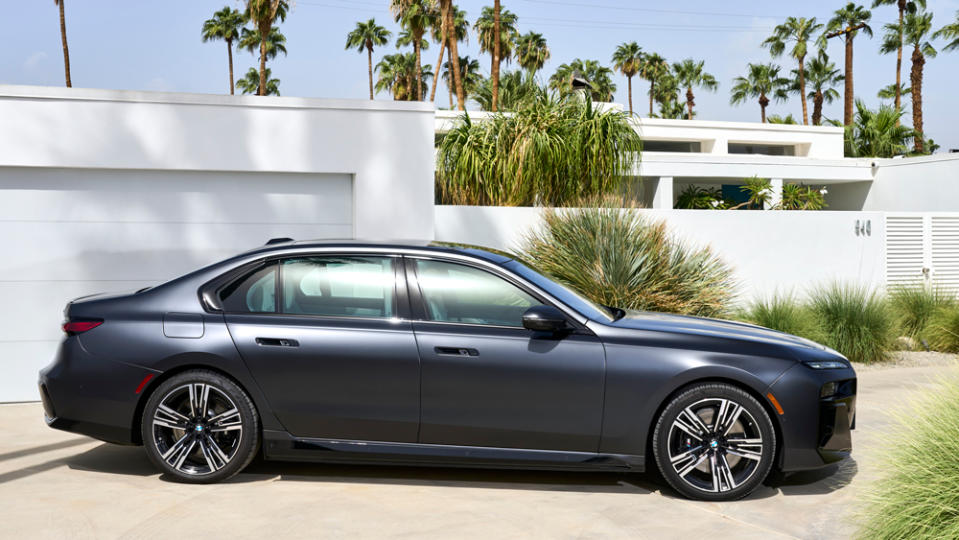
A recent renovation changed the House of Tomorrow back to its original white. If the i7’s quad, narrow LED headlamps could squint even harder and project holographic images from the film Blue Hawaii against that facade, the only thing missing at this drive-in theater would be popcorn (but they’re probably working on that back in Munich).
We could have sat in the rear seating area, referred to as the Executive Lounge, worked the 5.5-inch control modules in the doors’ armrests and enjoyed the 1961 movie on the 31.3-inch Theater Screen. Amazon Fire TV is included, and the car is 5G-compatible for high-quality streaming. And the 1,965 watt Bowers & Wilkins system has up to 36 speakers, as well as “exciters” sewn into the backrests for an even more visceral experience.
The i7 also introduces BMW IconicSounds Electric, an original score just for the car, with a panoply of choices ranging from spacy Sport Sound (appropriate for driving through canyons on Mars) to Relax Sound (which you would expect to hear in the lobby of, say, a Ritz-Carlton).
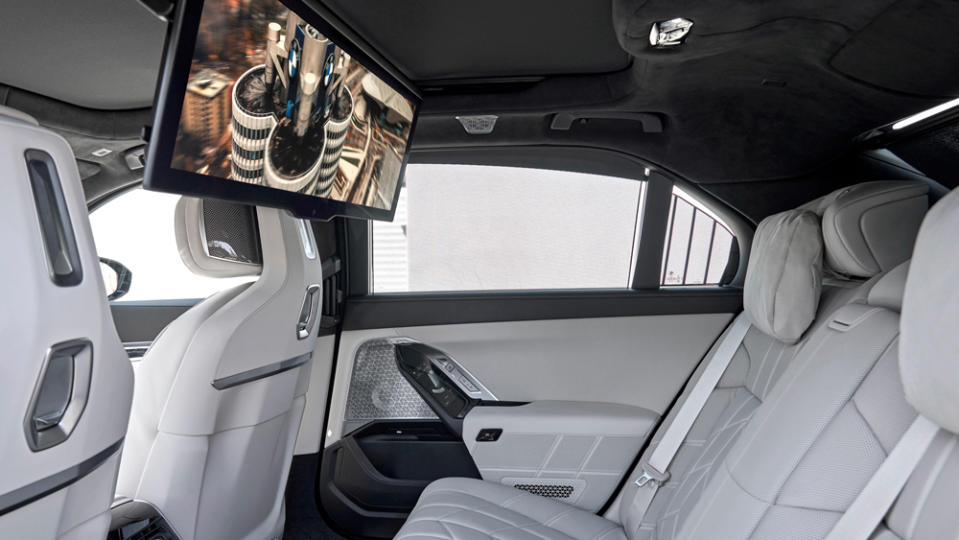
The i7 brought us to the House of Tomorrow without ever going from zero to 60 mph in 4.7 seconds or sprinting to its top speed of 149 mph. Instead, we slipped placidly through town traffic. The big struggle was adjusting minor functions via the 14.9-inch Curved Display touchscreen. More practice needed—and same for the automatic doors. Meantime, meet the Interaction Bar spreading across the dashboard: a beautiful new type of control for adjusting the four-zone climate control and operating other functions.
Even at a 40 percent state of charge, plenty of range remained from the maximum of 388 miles. The 101.7 kwh battery is packed with prismatic cells of different heights (up to 110 millimeters) that are fit into a discreet bellypan, feeding current to front and rear electric motors that combine for 544 hp and 549 ft lbs of torque, not to mention providing all-wheel drive. In other words, the i7 can hurtle along despite being a tad over chorus-line consideration at 5,985 pounds. A pink Cadillac of the House of Tomorrow’s era is generally at least 1,000 pounds lighter, but the i7 has driver aids like Maneuver Assistant (for automated parking) that help mitigate its heft.
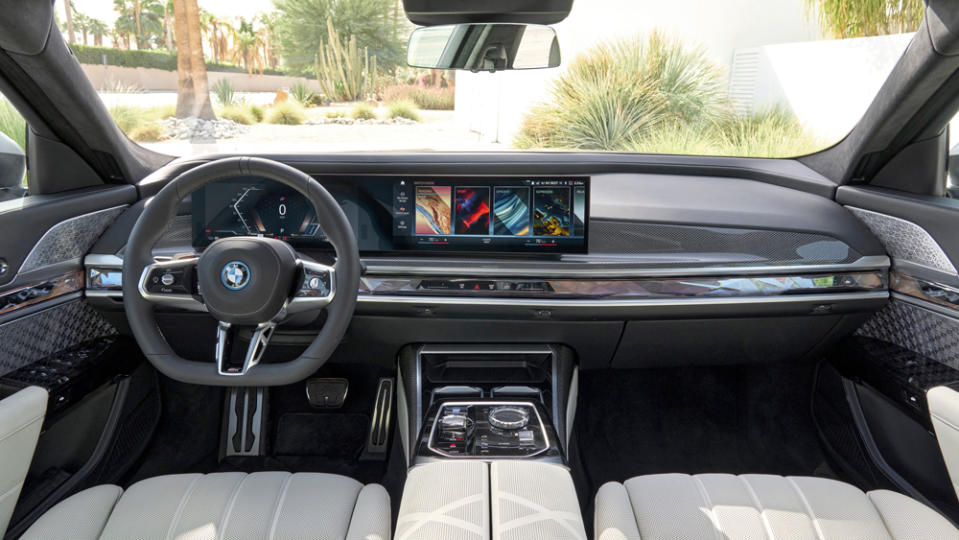
Sophisticated and complex, the i7 rings up a $113,600 tab, which seems downright generous when GMC has two trucks—the Hummer EV Edition 1 and Sierra EV—bettering a hundred large.
Before the midcentury-modern tour, I met Oliver Zipse, CEO of BMW, during a chauffeured i7 ride around Rancho Mirage. Zipse had just arrived after making a Rolls-Royce announcement at Goodwood and would soon be away to South Carolina to dispense $1.7 billion of new investment in the huge operation there. A little-known fact about him is that, in 1983, after high school in Germany, he moved with his family to Salt Lake City, Utah, where his father worked for BTW, a 3-D animation developer.
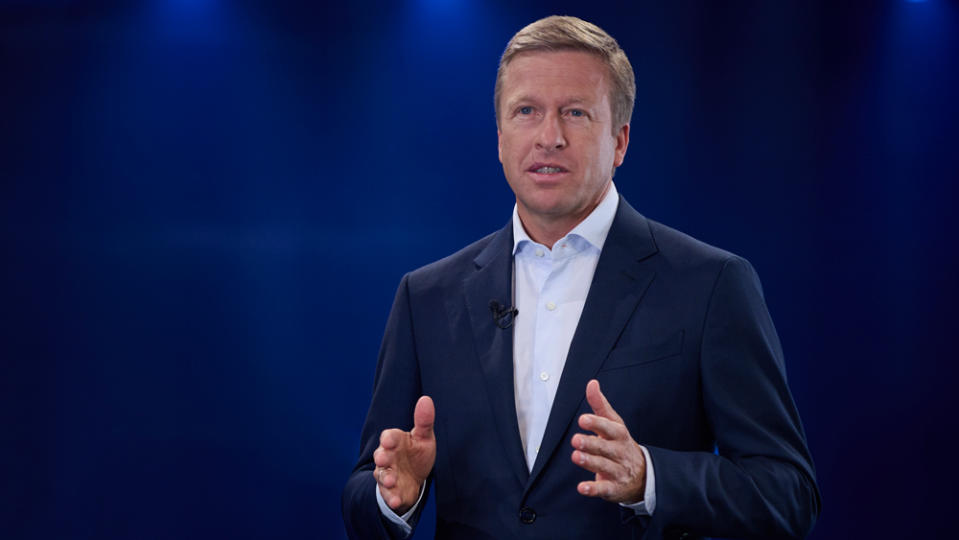
“All the kids were allowed to spend some leisure time at the University of Utah,” he says, laughing heartily. His leisure time involved math and computer science, but he adds, “If that’s your talent, you don’t have to push yourself too hard.” Pushing hard was reserved for the slopes of Alta and Snowbird.
As BMW’s CEO since 2019, Zipse led the company through the pandemic, including development of the new 7 Series, which he says required “enormous effort to make everyone believe that this is, for BMW, the right approach, because, of course, they read the same reports.” He is referring to news of the controversial practice of building electric and gas variants on the same dual-purpose structure, which leaves so much “scar tissue” that the recently introduced i4, which is the same size as the Tesla Model 3, weighs 1,000 pounds more. Zipse points out, however, that BMW is active in 140 global markets, and the single-platform, multiple-variant tactic is justified.

“Just to design one car for one market, a mass-manufacturer might do that,” he says, noting that BMW now has 3.4 percent of the global market (up from 2.9 percent at the start of his tenure) and makes around 2.5 million vehicles per year. “For us, it would be the wrong move. We are very happy that we took that [dual-purpose platform] route.”
In July, BMW stopped producing the revolutionary but slow-selling i3, yet Zipse cites it as an example of his doctrine. The boxy little car was a good way to school the company on electromobility, he says. While sending “a big impulse into the organization,” it nevertheless “stood aside of BMW” because of different manufacturing processes, including the carbon-fiber chassis. “Then the question was, ‘Do you continue to sidetrack, or do you go right to the heart of BMW?’ And we decided on the latter. What that means is that you [don’t have to] divide your company into two, into non-electric and electric. You will not survive that.”
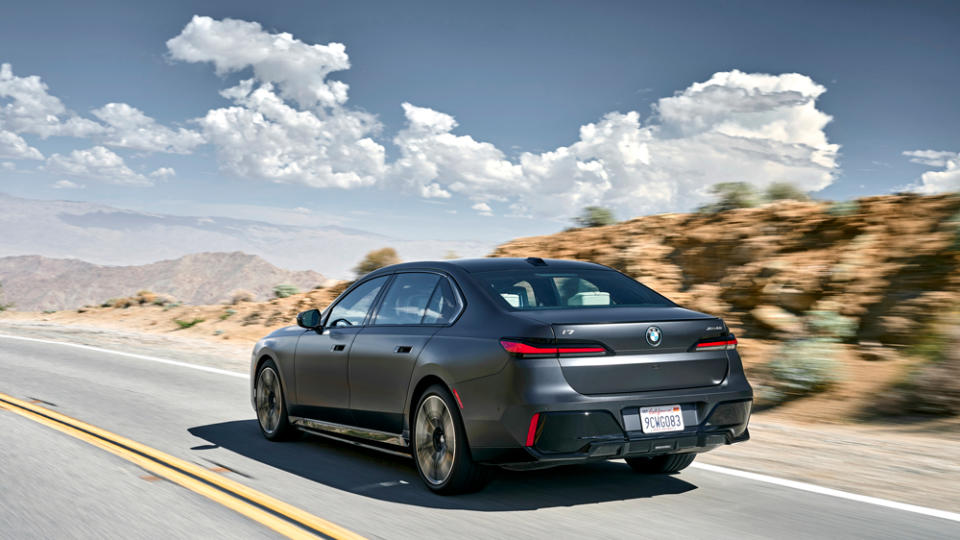
After time in the 760i xDrive60, I concluded that the car’s formal appearance—aimed first at the Chinese market, where 45 percent of production will be sold—could grow on me. And the single-platform strategy makes sense for now, especially when considering that, during his stopover in Goodwood, Zipse told the Bloomberg media outlet, “When it’s more scalable, hydrogen will be the hippest thing to drive.” A hydrogen-powered 7 series perhaps? Now that seems like the perfect vehicle for the House of Tomorrow’s driveway.
Click here for more photos of the 2023 BMW i7 xDrive60.

Best of Robb Report
The 15 Best Travel Trailers for Camping and Road-Tripping Adventures
The Chevy C8 Corvette: Everything We Know About the Powerful Mid-Engine Beast
Sign up for Robb Report's Newsletter. For the latest news, follow us on Facebook, Twitter, and Instagram.

